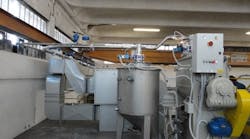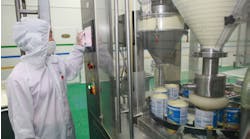Chemical companies' demands for conveying solutions that increase throughput, shorten lead times, handle vastly differing solids, reduce costs and simplify maintenance -- all while ensuring worker and plant safety -- are spurring suppliers to develop innovative solutions.
At dense-phase pneumatic conveying specialist Air-Tec, Calderara di Reno, Italy, for example, customers' desire to handle products with vastly different levels of abrasiveness is driving developments.
The company has installed conveyors at many chemical plants. "The most common challenge that we have to face is the abrasiveness of the product," says marketing and communication manager Fulvia Lombardo.
"Abrasive materials can wear the conveying line and be damaged by high-velocity transportation; thus we find the lower conveying velocity of a dense-phase system best. This lower speed, combined with a reduced amount of compressed air or other gases, avoids pipe wear, preserves the integrity of the product and contributes greatly to reduced maintenance costs," she adds.
The company uses air boosters to introduce gas into the conveying systems to reduce friction inside the pipes, and relies on anti-wear cast iron elbows to extend downtime intervals.
Air-Tec has just completed a project at the research center of a major European-based supplier of specialty cross-linkage compounds. The challenge here was to convey one metric ton of polyvinylidene fluoride (PVDF) powder per hour over a distance of 30 meters. The conveyor also had to be usable with materials both more abrasive and fragile than PVDF, and ensure the quality of all products during handling procedures.
To achieve this, the company installed a TPA (Air-Tec Pneumatic Transport) system, its most advanced offering, which provides greater flexibility and control of transport cycles. Material is discharged into the TPA from bags and conveyed the 30 meters to two hoppers with load cells connected to gravimetric feeders. Valves allow PVDF into the hopper; they close when the target weight has been reached (Figure 1).
"This solution has also met the requirement for flexibility and can be used to convey other materials with different levels of abrasiveness and fragility that might be present in the client laboratory," says Lombardo.
In a sign of what's to come, Air-Tec's research and development department is working on combining different ratios of air and inert gases to boost conveying efficiencies and save energy. In collaboration with engineers at the University of Bologna, Italy, the company has developed a mathematical model that enables plants to "drastically" reduce energy consumption during transport of any product, says Lombardo.
FLOWABILITY
Speaking at a bulk solids conference in Guangzhou, China, on May 20th, Jaime A Gómez, global business development manager for K-Tron, Pitman, N.J., pointed out that many variables must be considered when deciding how best to implement a pneumatic conveying strategy. However, he emphasized that the first priority is to address material flowability (Figure 2).
"Flowability is a function of the material, flow rates, and the equipment used. Thus, we need to understand a bit about each one of these factors. Material characterization allows us to understand the material we are dealing with. We need to understand the material behavior at the micro level (that is, particles) and the macro level (that is, in bulk quantities). Material particles interact with each other (particle/particle interactions), with the equipment (particle/equipment interactions) and with the environment (particle/environment interactions). The ability to flow also depends on the throughput (Kg/hr) and velocity (Km/hr). The last factor to be considered is the handling equipment. Geometry, distances, angles, surface finish, and agitation all influence flow behavior or flowability."
Gómez went on to highlight other variables that deal more with transport of bulk materials such as can and conveying velocities (Table 1).
Only when these are fully understood can factors such as method of pneumatic conveying -- for example, pressure or vacuum, and closed-loop nitrogen systems -- together with weighing and scaling systems and vacuum sequencing be implemented successfully.
OPERATIONAL ISSUES
One topic that certainly commands plant attention is reducing operating and maintenance costs, notes Hapman, Kalamazoo, Mich. Its MiniVac range of pneumatic conveyors are designed for installation flexibility and do away with the need for expensive plant air or separate compressors, says the company.
MiniVac's ease of cleaning was a key plus for a pharmaceutical application requiring a cleaning system that totally eliminated any possibility of cross-contamination during product changeovers.
Hapman engineered the system with individually controlled spray-wash ports placed throughout the interior of the conveyor. This self-contained design reliably cleans and sanitizes the conveyor's stainless steel interior without the need for time-consuming external procedures. The system also boasts quick filter cartridge change-outs; a clean-in-place rotary valve that allows disassembly, cleaning and reassembly within minutes; and sealed motors and controls rated for explosive atmosphere and washdown applications.
The pneumatic conveyor not only met all of the pharmaceutical maker's requirements but led to increases in efficiency and processing rates, says Hapman.
To cut maintenance downtime, the company has launched a managed maintenance program (MMP). This involves regularly scheduled inspections to spot potential wear and tear before it becomes an issue. The MMP also offers customized training to improve equipment uptime, performance and longevity.
Meanwhile, Flexicon, Bethlehem, Pa., is taking conveying to higher levels, quite literally.
One of the company's latest successes is a project for Oplex, Mexico City, one of Mexico's largest plastics processors. Installing a bulk bag unloading system for polyvinyl chloride (PVC) resin that combines both pneumatic and flexible screw conveying has streamlined materials handling, created a safer work environment and improved worker efficiency. The two separate pneumatic conveying lines prevent cross-contamination when running different products.
Flexicon had to adjust its Pneumati-con dilute-phase pneumatic conveying system to maintain performance at Mexico City's high altitude – 7,349 ft above sea level. This primarily involved ensuring that the fans cooling the motors generated enough air flow to be effective.
The accuracy of the now-automated system's loading, weighing and mixing operations has improved overall product quality and repeatability. In addition, using bulk bags in place of 25-kg sacks of PVC has reduced the amount of floor space needed for materials storage.
Flexibility is another advantage. A single conveyor can handle powders with a wide range of bulk densities, as well as flakes, pellets, capsules, tablets and other friable materials. Because the Pneumati-con system fully evacuates the vessel being discharged and the conveyor line itself, cross-contamination of multi-ingredient systems is minimized. The system also boasts easy-to-maintain filter receivers and rotary airlock valves.
PRESSURE BALANCE
One of the secrets of a successful and highly efficient pneumatic conveying system, whether a high-pressure dense-phase system or a low-pressure dilute-phase, is achieving an optimum pressure balance, notes Dynamic Air, St. Paul, Minn.
Many systems operate in an unstable or unbalanced pressure condition, says the company. This means the conveying system can be using either too much or not enough compressed air, both of which are undesirable.
To effectively counterbalance all the friction factors normally inherent in a pneumatic conveying system, Dynamic Air has developed DC-5 Air Saver technology, which accurately controls and pressure balances the pneumatic conveying system. It achieves the proper pressure balance by automatically sensing system conditions and reacting instantaneously and accurately without overcompensation. So material is conveyed through the line in a smooth, controlled manner and at the desired velocity, to optimize the conveying process for higher performance and reliability.
DC-5 Air Saver cuts energy consumption, improves system reliability, allows highly abrasive materials to be transported, reduces dust handling requirements, and decreases the dynamic loading experienced at pipe bends by controlling the conveying velocity, says the company.
Seán Ottewell Editor at Large. You can e-mail him at [email protected].


